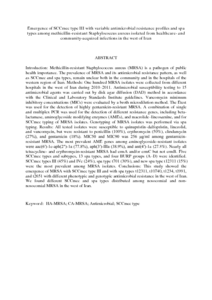Citation
Mohammadi, Sattar and Sekawi, Zamberi and Monjezi, Azam and Maleki, Mohammad-Hossein and Soroush, Setareh and Sadeghifard, Nourkhoda and Pakzad, Iraj and Jalilian, Farid Azizi and Emaneini, Mohammad and Asadollahi, Khairollah and Pourahmad, Fazel and Zarrilli, Raffaele and Taherikalani, Morovat
(2014)
Emergence of SCCmec type III with variable antimicrobial resistance profiles and spa types among methicillin-resistant Staphylococcus aureus isolated from healthcare- and community-acquired infections in the west of Iran.
International Journal of Infectious Diseases, 25.
pp. 152-158.
ISSN 1201-9712; ESSN: 1878-3511
Abstract
Introduction: Methicillin-resistant Staphylococcus aureus (MRSA) is a pathogen of public health importance. The prevalence of MRSA and its antimicrobial resistance pattern, as well as SCCmec and spa types, remain unclear both in the community and in the hospitals of the western region of Iran. Methods: One hundred MRSA isolates were collected from different hospitals in the west of Iran during 2010–2011. Antimicrobial susceptibility testing to 15 antimicrobial agents was carried out by disk agar diffusion (DAD) method in accordance with the Clinical and Laboratory Standards Institute guidelines. Vancomycin minimum inhibitory concentrations (MICs) were evaluated by a broth microdilution method. The Etest was used for the detection of highly gentamicin-resistant MRSA. A combination of single and multiplex PCR was used for the detection of different resistance genes, including beta-lactamase, aminoglycoside modifying enzymes (AMEs), and macrolide–lincosamine, and for SCCmec typing of MRSA isolates. Genotyping of MRSA isolates was performed via spa typing. Results: All tested isolates were susceptible to quinupristin–dalfopristin, linezolid, and vancomycin, but were resistant to penicillin (100%), erythromycin (50%), clindamycin (27%), and gentamicin (18%). MIC50 and MIC90 was 256 μg/ml among gentamicin-resistant MRSA. The most prevalent AME genes among aminoglycoside-resistant isolates were aac(6′)-1e-aph(2″)-1a (77.8%), aph(3′)-IIIa (38.9%), and ant(4′)-1a (27.8%). Nearly all tetracycline- and erythromycin-resistant MRSA had ermA and/or ermC but not ermB. Five SCCmec types and subtypes, 13 spa types, and four BURP groups (A–D) were identified. SCCmec types III (45%) and IVc (24%), spa type t701 (30%), and new spa type t12311 (15%) were the most prevalent among MRSA isolates. Conclusions: This study showed the emergence of MRSA with SCCmec type III and with spa types t12311, t10740, t1234, t1991, and t2651 with different phenotypic and genotypic antimicrobial resistance in the west of Iran. We found different SCCmec and spa types distributed among nosocomial and non-nosocomial MRSA in the west of Iran.
Download File
![[img]](http://psasir.upm.edu.my/37429/1.hassmallThumbnailVersion/Emergence%20of%20SCCmec%20type%20III%20with%20variable%20antimicrobial%20resistance%20profiles%20and%20spa%20types%20among%20methicillin.pdf)  Preview |
|
PDF (Abstract)
Emergence of SCCmec type III with variable antimicrobial resistance profiles and spa types among methicillin.pdf
Download (190kB)
| Preview
|
|
Additional Metadata
Actions (login required)
 |
View Item |

